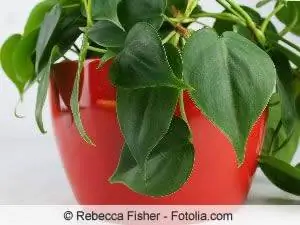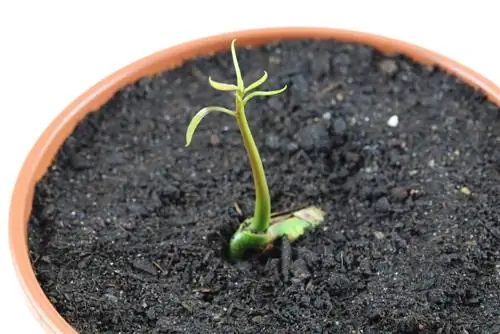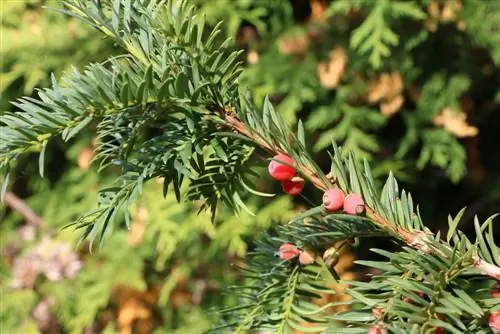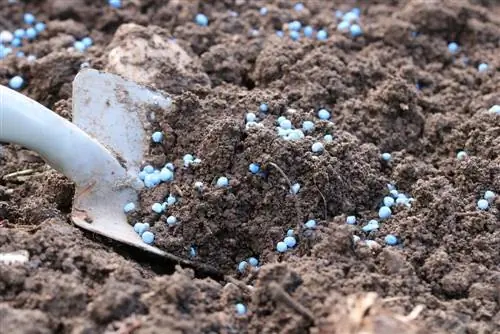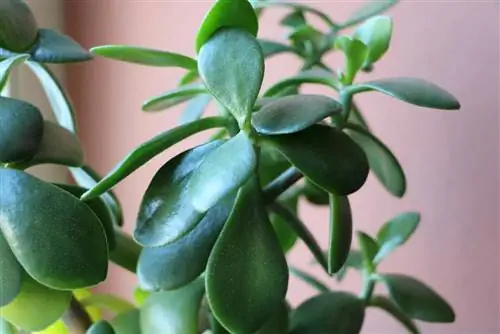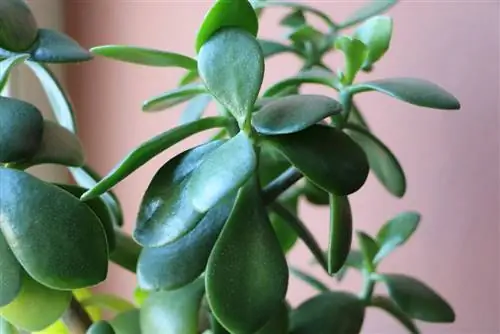- Author admin [email protected].
- Public 2023-12-17 03:39.
- Last modified 2025-01-24 12:45.
Ambitious hobby gardeners will never get tired of its evergreen opulence, because the tree lover knows how to showcase it in style. The structure of its large, lush green leaves and its imposing silhouette give the Philodendron erubescens a truly architectural component. At the same time, the tropical climbing plant filters pollutants from the air, which underlines its importance as a valued houseplant. Although this exotic plant is lightly declared to be a typical bachelor plant, the significant aspects of the following care instructions must be taken into account for successful cultivation.
Profile
- Plant family Araceae
- Name of the species: Philodendron erubescens
- Common name: Tree Friend
- native to the tropical rainforests of South America
- Growth height in culture up to 200-300 cm
- evergreen climbing plant
- green shiny leaves 40 cm long and 20 cm wide
- Stem and petioles with purple coloring
- poisonous in all parts
Location
If you want the tree friend to look good in your room, the choice of location plays a central role. Although the decorative foliage plant provides green liveliness in a dim corner, it only develops its unique character under the following light and temperature conditions:
- ideally a sunny to partially shaded spot on the west or east window
- optionally on the south window with shading option in bright sunlight
- normal room temperatures of 18 to 28 °C all year round
- Consider minimum temperature of 14 °C
- above-average humidity of 60 percent and higher
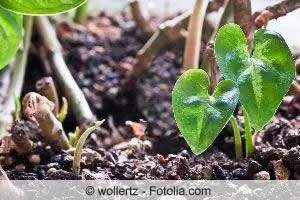
To meet the desire for higher humidity, spray a Philodendron erubescens regularly with low-lime water. An excellent solution in this regard is a saucer filled with water and pebbles. The evaporating water coats the dense greenery with a mist, making the tree lover feel at home.
Tip:
A tropical tree friend thrives particularly well in the humid, warm room climate of the bathroom.
Substrate and climbing aid
In its natural range, philodendrons live in peaceful coexistence with large trees by climbing up them. The green plants also absorb moisture and nutrients with their aerial roots, but the central supply comes from the main root in the ground. As a result, a tree friend thrives in a pot like a typical houseplant, while a climbing aid is also recommended. To give them the best support, we recommend sticks wrapped in jute or sisal. A very natural appearance is created when using moss-covered sticks. An adequate substrate has the following properties:
- nutrient-rich, humus-rich and well-drained potting soil
- preferably potting soil enriched with compost or leaf mold
- the addition of perlite, expanded clay, sand or coconut fibers optimizes permeability
If the surface of the support rod is not too smooth, the climbing roots will grow independently. An appropriate height must be chosen right from the start, as it will be difficult to loosen the roots later in order to replace a rod that is too low.
Watering and fertilizing
The tree lover wants a constantly moist substrate that doesn't bother his roots with waterlogging. Frequent watering is therefore of utmost importance for lush growth.
- if the substrate surface dries, it is watered
- collected rainwater or stale tap water are recommended
- empty the coaster after 20 minutes unless it is filled with pebbles
- Administer a liquid fertilizer for green plants every 14 days from March to August
As long as the bucket is still easy to handle, the immersion method is a good option for supplying water. To do this, lift the pot into a container filled with water. The root ball is soaked in this until no more air bubbles appear. After the excess water has drained away, the Philodendron erubescens takes its original place again.
Tip:
The rich green, shiny color of the leaf decoration is shown even better if the leaves are occasionally wiped on the top and bottom with algae juice.
Wintering
The tree lover does not go into hibernation in the true sense of the word. Rather, it slows down its metabolism slightly to adapt to the darker lighting conditions. This results in a lower need for irrigation water. Fertilizer is not administered during this phase. Temperatures must not fall below 14 °C, even during the cold season. In view of the dry heating air, the air humidity must be kept at a higher level. Bowls filled with water on the radiators provide relief. Special decorative vessels that are hung on the ribs of the radiators as humidifiers and filled with water are prettier to look at.
Cutting
In view of the remarkable speed of growth, blending is desirable, especially when space is limited. The best time for this care measure is during the transition phase from the winter rest period to the new growing season. In principle, pruning is possible throughout the summer. The extent to which you cut back the tree friend is at your individual discretion. Further branching is sustainably encouraged if the individual cut takes place just above an outward-facing leaf node. If possible, the aerial roots are spared from cutting. Wearing gloves is essential during this work due to the high toxicity of the plant sap. The cutting tool is thoroughly cleaned and disinfected before and after cutting to effectively prevent infections.
Repotting
The rapid growth of a Philodendron erubescens is accompanied by annual repotting. If the existing planter is completely rooted, the care protocol is expanded to include this aspect. If the winter rest period is coming to an end, this is the ideal time to move to a larger pot. Here's how to do it:
- In the new bucket, create a drainage system made of pebbles, grit or pottery shards above the bottom opening
- spread a water- and air-permeable fleece over it
- fill in a first layer of the substrate and compact it slightly
- Unpot the tree friend and carefully remove the used soil
- insert into the middle of the pot to fill the cavities with substrate
Cautious hobby gardeners do not neglect to leave a watering edge free so that watering does not always result in water spilling over. The potted root ball is subjected to a thorough check on this occasion. Root strands that appear withered or rotten are cut out.
Propagate
If you would like more copies of your Philodendron erubescens, head cuttings are an excellent propagation material. You can obtain these during pruning or remove them during the summer. A perfect cutting is about 15 centimeters long and is cut off just below a leaf node. Follow these steps:
- Leave the lower half of the cutting.
- Cut the remaining leaves in half to reduce energy consumption.
- Pour potting soil into small pots and insert a cutting into each.
- Moisten the substrate and place the container in a partially shaded, warm place.
Rooting occurs particularly quickly if you put a plastic bag over the pot. The growing soil must not dry out afterwards. The cover is ventilated daily to prevent mold from forming. If new shoots appear, propagation is proceeding as desired. The hood is now no longer required. As soon as the cultivation pot has roots, the young plant is repotted and cared for like an adult tree friend.
Conclusion of the editors
The tree friend is rightly considered a characterful and undemanding houseplant. The tropical climbing plant creates an evergreen feel-good atmosphere in every room with its lush leaf decorations. Since the huge leaves not only shimmer elegantly, but also filter toxins from the air we breathe, the reasons for the enormous popularity of Philodendron erubescens are obvious. You benefit from all of these advantages without any extensive work. It is enough to internalize the most important basics of these care instructions and the green plant will develop its full potential. The focus is on abundant watering and regular fertilization, in conjunction with a partially shaded, warm location. It is important to note the toxic content of the arum plant, which requires you to wear gloves.
Things worth knowing about Tree Friend in brief
Special features
- The Philodendron, also called tree friend, is a plant that comes from South and Central America and occurs in a variety of species.
- A distinction is made between fast-growing climbing, slow-growing climbing and non-climbing species.
- The species most commonly found in the home is the Philodendron scandens. It is one of the fast-growing climbing species.
- All parts of the Philodendron are poisonous if eaten. So be careful if you have pets.
Care
- The Philodendron needs a partially shaded to shady location. It must not be placed in direct sunlight.
- You can plant the Philodendron in green plant soil or hydroponically.
- The Philodendron is repotted when its roots fill the planter. This should not be done in winter.
- The soil should always be kept moist. However, waterlogging must be avoided.
- From spring to autumn, the philodendron should be fertilized every two weeks with a liquid fertilizer.
- In winter, the temperature of the location must not permanently fall below 15° C.
- The leaves of the philodendron should be wiped off with a damp cloth from time to time.
Climbing Philodendron species need climbing aid in the form of a trellis or trellis. This is where the aerial roots find support and supply the plant with additional nutrients. If you cover the climbing aid with moss or build it from branches with coarse bark, the aerial roots will find better support more quickly. Otherwise you can first tie the aerial roots to the trellis until the aerial roots have anchored themselves.
- If you want to keep the philodendron as a hanging plant, it obviously doesn't need a trellis. But then you have to shorten the aerial roots every now and then.
- Aerial roots can be cut off to a certain extent if they get too long.
- The tendrils of the Philodendron can be cut back at any time.
- Climbing types of Philodendron can be grown from cuttings. The cut shoot is placed in water and takes root quite quickly.
- Non-climbing species of Philodendron are grown from seeds.
Problems
- Pale leaves: Pale leaves indicate a nutrient deficiency. To remedy this, fertilize regularly and repot if necessary.
- Brown spots on the leaves: If these spots are dry, it is sunburn. To remedy this, give the plant a less sunny location. If the spots are moist, the philodendron has been watered too much. As a countermeasure, let the soil dry out. If waterlogging has formed, repot in fresh soil and carefully remove rotten root parts.
- Sticky spots on leaves: Sticky spots on plant leaves indicate scale insects. Of the insects themselves, you can usually see the up to 5 mm large, white to brown, round or elongated shields of the females, under which the eggs lie. Unfortunately, fighting scale insects is quite difficult because they can multiply explosively and the eggs are well protected under the shield of the females. A plant infected with scale insects must be isolated to prevent the pests from spreading further.
Popular style
Philodendron scandens is one of the easiest houseplants to care for. It has 7.5 - 10 cm long, heart-shaped, shiny leaves and can be grown as a hanging or climbing plant or when the growth tips are broken off. Climbing philodendrons find good support on moss sticks, bushy species do not require support.

